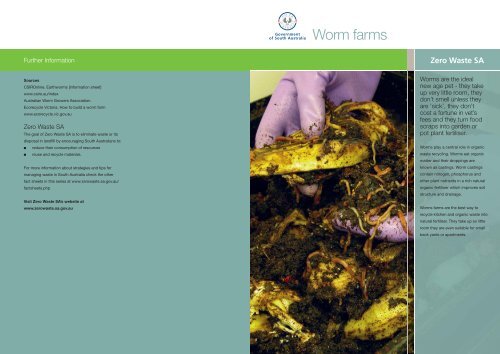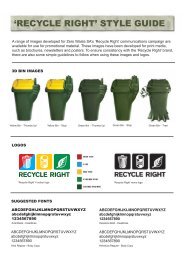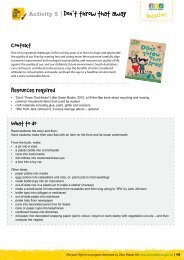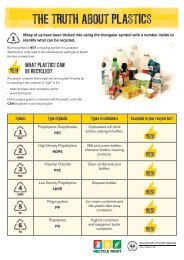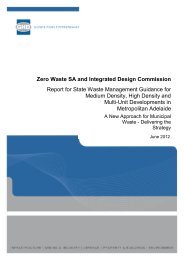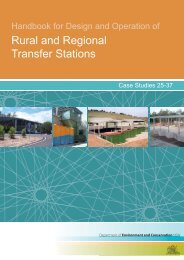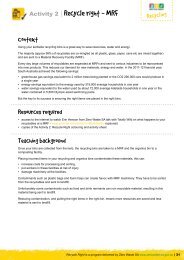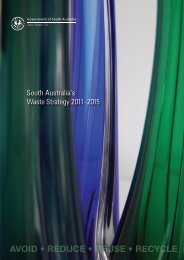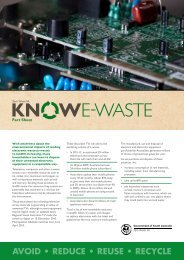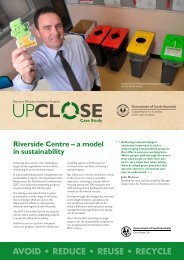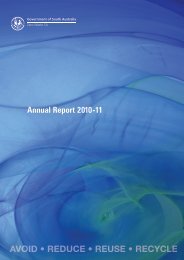Worm Farms fact sheet - Zero Waste SA - SA.Gov.au
Worm Farms fact sheet - Zero Waste SA - SA.Gov.au
Worm Farms fact sheet - Zero Waste SA - SA.Gov.au
- No tags were found...
Create successful ePaper yourself
Turn your PDF publications into a flip-book with our unique Google optimized e-Paper software.
<strong>Worm</strong> farmsFurther Information<strong>Zero</strong> <strong>Waste</strong> <strong>SA</strong>SourcesCSIROnline. Earthworms [information <strong>sheet</strong>]www.csiro.<strong>au</strong>/indexAustralian <strong>Worm</strong> Growers Association.Ecorecycle Victoria. How to build a worm farmwww.ecorecycle.vic.gov.<strong>au</strong><strong>Zero</strong> <strong>Waste</strong> <strong>SA</strong>The goal of <strong>Zero</strong> <strong>Waste</strong> <strong>SA</strong> is to eliminate waste or itsdisposal in landfill by encouraging South Australians to:■ reduce their consumption of resources■ reuse and recycle materials.For more information about strategies and tips formanaging waste in South Australia check the other<strong>fact</strong> <strong>sheet</strong>s in this series at www.zerowaste.sa.gov.<strong>au</strong>/<strong>fact</strong><strong>sheet</strong>s.phpVisit <strong>Zero</strong> <strong>Waste</strong> <strong>SA</strong>’s website atwww.zerowaste.sa.gov.<strong>au</strong><strong>Worm</strong>s are the idealnew age pet - they takeup very little room, theydon’t smell unless theyare ‘sick’, they don’tcost a fortune in vet’sfees and they turn foodscraps into garden orpot plant fertiliser.<strong>Worm</strong>s play a central role in organicwaste recycling. <strong>Worm</strong>s eat organicmatter and their droppings areknown as castings. <strong>Worm</strong> castingscontain nitrogen, phosphorus andother plant nutrients in a rich naturalorganic fertiliser which improves soilstructure and drainage.<strong>Worm</strong>s farms are the best way torecycle kitchen and organic waste intonatural fertiliser. They take up so littleroom they are even suitable for smallback yards or apartments.
What kinds of worms?Compost earthworms, which go by such names astiger worms, red wrigglers and Indian blues, cantolerate the rich conditions of worm farms.Ordinary garden earthworms do not do well in wormfarms, as the concentration of organic matter is toohigh for them. In the garden, though, they also aeratethe soil and their castings increase a soils ability tohold water and nutrients.<strong>Worm</strong> <strong>fact</strong>s■ Earthworms are hermaphrodites but they still needa partner to reproduce.■ In favourable conditions, worms breed every 7–10days and can double their population in 90 days.■ In South Australian trials, worm compost appliedin vineyards led to increased yields.■ <strong>Worm</strong>s are made almost entirely of water andbreathe through their skins.Starting upPlenty of ready-made stackable worm farms, andworms, are available from suppliers listed in the YellowPages www.yellowpages.com.<strong>au</strong> under ‘<strong>Worm</strong> <strong>Farms</strong>’,on the internet, or from some local councils andnurseries. <strong>Worm</strong> farms purchased from retail suppliersusually contain instructions, <strong>fact</strong>s and handy hints tohelp you.Making your own farm is not such a difficult task. Startwith 1000 to 2000 worms.Use clean boxes made from wood, styrofoam or otherplastic materials, with lids and:■ punch small holes all over the sides and basefor ventilation■ line the box with several <strong>sheet</strong>s of newspaper■ line the newspaper with bedding made up of■ well-rotted moist compost■ shredded wet newspaper■ dead leaves■ straw■ sawdust or peat moss■ a mixture of these■ water the box well but make sure the bedding isnot soggy■ cover the top with dampened hessian ornewspaper to keep the moisture in and light out,and put the lid on■ find a cool shady spot for the farm■ put the box on bricks or wooden blocks■ place a tray under it to catch excess liquid whichcan be used for fertiliser.What do worms eat?■ Fruit and vegetable scraps■ Bread■ Crushed egg shells■ Grains■ Pasta■ Tea leaves and bags■ PaperWhat don’t worms eat?■ citrus peels■ onions■ dairy products■ fats and oils■ meat and fish■ animal droppingsCollect scraps in a container in the kitchen. Feedthe worms with small amounts of scraps daily,increasing the amount as they start to multiply.Add enough water to make sure the farm doesnot dry out.Collect the worm castings and use it in gardencompost or add it to potting mix. Seeds maygerminate in the castings from material placed inthe worm farm.After a few months the worm population willstabilise. <strong>Worm</strong> numbers will only continue growwith more food and enough space. At this stageyou can start up a new farm by moving some of theworms to a new box.Troubleshooting in the worm farmPROBLEM PROBABLE CAUSE SOLUTION<strong>Worm</strong>s dying Too hot Move to a cooler spotToo dryAdd water<strong>Worm</strong>s trying to escape Insufficient material Add more beddingToo dryMoisten beddingToo wetMix food with beddingToo hotShift farm to cooler location<strong>Worm</strong> farm smells Too much food Mix food with bedding dailyNot enough airLeave the lid partially openAdd more ventilation holesFeeding with wrong foodsRemove any meat or fats<strong>Worm</strong>s have died due to very hotconditionsPut farm in a cool position and getmore worms


